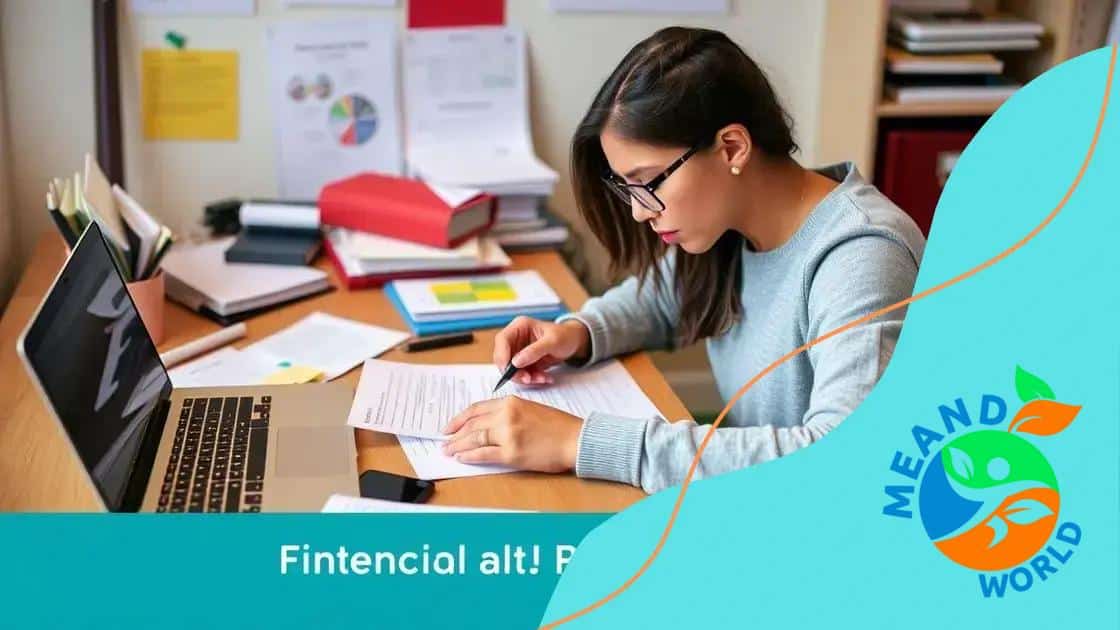Financial aid programs for students with disabilities

Anúncios
Financial aid programs for students with disabilities include grants, scholarships, loans, and work-study options, offering essential support to cover educational costs and enhance accessibility.
Financial aid programs for students with disabilities are crucial in making education accessible. Have you considered how these programs can help bridge the gap for students facing challenges? Let’s dive into the options available.
Anúncios
Understanding financial aid programs
Understanding financial aid programs can be a game-changer for students in need. These programs are designed to lighten the financial burden of education, particularly for those with disabilities.
Anúncios
Types of financial aid can vary widely. You might find grants, scholarships, loans, and work-study options. Each type serves a unique purpose and can help cover different education-related expenses.
Grants
Grants are typically awarded based on financial need and do not require repayment. They are often provided by the government or educational institutions.
Scholarships
Scholarships are funds that you don’t have to pay back. They can be merit-based or need-based, and many are specifically for students with disabilities.
Loans
Loans are amounts borrowed that must be repaid with interest. While they can provide immediate funds, understanding the terms is crucial.
- Federal student loans may have lower interest rates.
- Private loans often have stricter repayment terms.
- Research your borrowing limits and repayment options.
Moreover, the work-study program offers students a chance to earn money while studying. This can significantly help manage living expenses and tuition fees. With flexible hours, it’s generally structured around your class schedule, making it easier to balance work and studies.
It’s vital to explore what’s available and determine the best fit for your needs. Often, schools have dedicated offices to assist students with navigating financial aid programs. Utilize these resources to guide you through the application process, which can be daunting but is essential for securing financial support.
By understanding the various types of aid and how to apply for them, you can make the cost of education more manageable. With the right financial support, pursuing your academic goals becomes much more accessible.
Types of aid available
Understanding the types of aid available is crucial for students with disabilities. Each option comes with its benefits, helping to ease the costs of education.
There are several main categories of financial aid that students can explore. These include grants, scholarships, loans, and work-study programs. Knowing the differences between these types can help you make informed decisions about your education funding.
Grants
Grants are often need-based and do not require repayment. They can be offered by the federal government, state governments, or school institutions. Applying for grants should be a top priority for every student seeking assistance.
Scholarships
Scholarships are another excellent source of funding. These can be awarded based on merit, need, or specific criteria related to the student’s background. Many scholarships are specifically targeted at students with disabilities.
Loans
Loans are funds that students borrow and must repay with interest. There are federal loans and private loans, each having different terms and conditions. It’s important to understand the repayment options available before committing to a loan.
- Federal loans often have lower interest rates and better repayment terms.
- Private loans may be harder to get and come with stricter payment requirements.
- Always compare loan options to find the most favorable terms.
In addition to these, work-study programs offer students jobs to help pay for educational expenses. This program gives students the chance to earn money while enrolled in school, making it a great way to gain experience and alleviate financial stress.
By understanding the different types of aid available, students can better navigate their financial options. This knowledge is key to finding the right support to achieve academic goals.
How to apply for financial assistance

Knowing how to apply for financial assistance is a critical step for students, especially those with disabilities. The application process might seem daunting, but with the right information, you can make it easier.
First, gather all necessary documents. Typically, you will need your financial information, identification, and any relevant educational records. This will help streamline the application process and ensure you have everything ready to go.
Fill Out the FAFSA
The Free Application for Federal Student Aid (FAFSA) is usually the first step in applying for financial assistance. This form collects essential information to determine your eligibility for various types of aid.
Research Other Applications
In addition to the FAFSA, some states and schools have their own applications for financial aid. Always check the specific requirements for your state and school. Each program may ask for different information.
Meet Deadlines
Staying aware of deadlines is crucial. Each financial assistance program has its own submission date. Missing a deadline could mean you lose out on potential aid.
- Check your state’s financial aid website for deadlines.
- Create a calendar with important dates.
- Set reminders to stay on track.
Once you submit your applications, be prepared to provide additional information if requested. This may include answering questions or supplying more documents. Clear communication is essential during this time.
After applying, you will receive a Student Aid Report (SAR) that summarizes your information. Review this carefully to ensure everything is correct. If there are issues, contact the relevant financial aid office for clarification.
In summary, by knowing how to apply for financial assistance and being organized, you can maximize your chances of receiving the aid you need to pursue your education goals.
Resources for students with disabilities
When looking for resources for students with disabilities, it’s important to know where to start. Many organizations and institutions provide valuable support to help students succeed in their educational journeys.
First, consider campus resources. Most schools have a dedicated office for students with disabilities. These offices can help with accommodations and provide personalized support. They often participate in the planning of your educational plan and ensure you have what you need to thrive.
National Organizations
Many national organizations also offer resources. These groups provide information, advocacy, and sometimes even funding. Organizations like the National Federation of the Blind and CAST focus on disability awareness and support.
Mentorship Programs
Mentorship programs can also be incredibly beneficial. Connecting with a mentor who has navigated similar challenges can provide insights and encouragement. These relationships can be invaluable in your academic and personal growth.
- Look for local mentor programs available through your school or community.
- Online platforms may offer virtual mentorships, expanding your options.
- Consider joining support groups that address similar experiences.
Additionally, online resources are plentiful. Websites like www.disability.gov offer various information and can connect you with services in your area. These platforms often contain articles, forums, and other tools tailored to your needs.
Staying informed about the various resources for students with disabilities can greatly enhance your educational experience. By utilizing these resources, you gain access to the support systems needed to pursue your academic goals successfully.
Common misconceptions about financial aid
Many students have common misconceptions about financial aid that can prevent them from accessing the support they need. Understanding these myths is essential for making informed decisions about funding your education.
One major myth is that financial aid is only available to those with low incomes. While income does play a significant role in determining eligibility, many scholarships and grants are available based on other criteria as well. Academic performance, community service, and specific talents can also lead to financial aid opportunities.
Myth: All aid has to be repaid
Another common belief is that all forms of financial aid must be repaid. This is not true. Grants and scholarships are considered gift aid, meaning they do not require repayment. It’s crucial to research which options are available to you.
Myth: Applying for aid is too complicated
Many students think that the application process for financial aid is unnecessarily complex. In reality, while it does require careful attention to detail, resources are available to guide you through it. The FAFSA is designed to be user-friendly, and many schools offer assistance in completing the application.
- Visit your school’s financial aid office for help.
- Use online resources and tutorials to ease the process.
- Don’t hesitate to reach out for guidance if needed.
Some believe that if they wait until later in their college experience to apply, they will have better chances. However, many forms of financial aid are available only to those who apply early. Missing deadlines can limit your options significantly.
It’s vital to recognize that these common misconceptions about financial aid can lead to missed opportunities. By educating yourself and understanding the truth about financial aid, you can improve your chances of receiving the financial support you need for your education.
Understanding financial aid programs is essential for students, especially those with disabilities. By recognizing the various types of aid available and how to apply, students can navigate the process more effectively. It’s crucial to debunk common misconceptions to ensure that everyone can access the support they deserve. Utilize the resources at your disposal, and don’t hesitate to seek help. With the right information and support, pursuing your education can become a manageable and exciting journey.
FAQ – Frequently Asked Questions About Financial Aid Programs for Students with Disabilities
What types of financial aid are available for students with disabilities?
Students with disabilities can access various forms of financial aid, including grants, scholarships, loans, and work-study programs.
How do I apply for financial assistance?
To apply for financial assistance, you should fill out the FAFSA, check for additional state or school applications, and meet all deadlines.
Do I have to pay back all financial aid?
No, not all financial aid needs to be repaid. Grants and scholarships are typically gift aid that does not require repayment.
Are there resources available to help me understand financial aid?
Yes, schools often provide resources through financial aid offices, and national organizations can also offer guidance and support.





